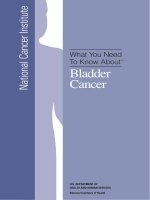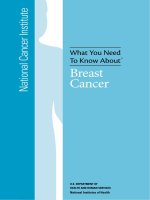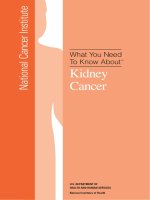Tài liệu What You Need To Know About™ - Thyroid Cancer docx
Bạn đang xem bản rút gọn của tài liệu. Xem và tải ngay bản đầy đủ của tài liệu tại đây (1.03 MB, 48 trang )
National Cancer Institute
What You Need
To Know About
™
yroid
Cancer
U.S. DEPARTMENT OF
HEALTH AND HUMAN SERVICES
National Institutes of Health
National Cancer Institute Services
is is only one of many free booklets for
people with cancer.
You may want more information for yourself,
your family, and your doctor.
NCI oers comprehensive research-based
information for patients and their families,
health professionals, cancer researchers,
advocates, and the public.
Call NCI’s Cancer Information Service
1-800-4-CANCER (1-800-422-6237)
Visit NCI’s website
Chat online
LiveHelp, NCI’s instant messaging service
/>E-mail
cancergovstaff@mail.nih.gov
Order publications
1-800-4-CANCER
Get help with quitting smoking
1-877-44U-QUIT (1-877-448-7848)
Contents
1 About is Booklet
3 e yroid
5 Cancer Cells
6 Types of yroid Cancer
8 Diagnosis
10 Staging
11 Treatment
15 Surgery
18 yroid Hormone Treatment
19 Radioactive Iodine erapy
22 External Radiation erapy
24 Chemotherapy
25 Second Opinion
27 Follow-up Care
29 Sources of Support
30 Taking Part in Cancer Research
32 Words to Know
41 National Cancer Institute Publications
1
About is Booklet
is National Cancer Institute (NCI) booklet is for you—
someone who has just been diagnosed with cancer of
the thyroid.
is booklet shows words that may be new to you in bold.
See the Words to Know section to learn what a new word
means and how to pronounce it.
In 2012, more than 43,000 women and 13,000 men will be
diagnosed with thyroid cancer in the United States. Most
will be older than 45.
Learning about medical care for thyroid cancer can help you
take an active part in making choices about your care. is
booklet tells about…
■ Diagnosis and staging
■ Treatment
■ Follow-up care
■ Taking part in research studies
You can read this booklet from front to back. Or you can
read only the sections you need right now.
is booklet has lists of questions that you may want to
ask your doctor. Many people nd it helpful to take a list
of questions to a doctor visit. To help remember what your
doctor says, you can take notes. You may also want to have a
family member or friend go with you when you talk with the
doctor—to take notes, ask questions, or just listen.
2
For the latest information about thyroid cancer, please visit
NCI’s website at />types/thyroid.
Also, NCI’s Cancer Information Service can answer your
questions about cancer. We can also send you NCI booklets
and fact sheets. Call 1-800-4-CANCER (1-800-422-6237).
Or, chat using LiveHelp, NCI’s instant messaging service, at
/>3
e yroid
e thyroid is a gland at the front of your neck beneath your
voice box (larynx). A healthy thyroid is a little larger than a
quarter. It usually can’t be felt through the skin.
e thyroid has two parts (lobes). A thin piece of tissue (the
isthmus) connects the two lobes.
e thyroid makes hormones:
■ yroid hormone: e thyroid follicular cells make
thyroid hormone. is hormone aects heart rate, blood
pressure, body temperature, and weight. For example,
too much thyroid hormone makes your heart race, and
too little makes you feel very tired.
■ Calcitonin: e C cells in the thyroid make calcitonin.
is hormone plays a small role in keeping a healthy
level of calcium in the body.
Four or more tiny parathyroid glands are on the back of
the thyroid. ese glands make parathyroid hormone. is
hormone plays a big role in helping the body maintain a
healthy level of calcium.
4
Lymph nodes
Isthmus
Thyroid
Larynx
Parathyroid
glands
Lobes
Isthmus
The pictures show the front and back of the thyroid.
5
Cancer Cells
Cancer begins in cells, the building blocks that make up
tissues. Tissues make up the thyroid and other organs of
the body.
Normal thyroid cells grow and divide to form new cells as
the body needs them. When normal cells grow old or get
damaged, they die, and new cells take their place.
Sometimes, this process goes wrong. New cells form when
the body does not need them, and old or damaged cells
do not die as they should. e buildup of extra cells oen
forms a mass of tissue called a nodule. It may also be called a
growth or tumor.
Most thyroid nodules are benign. Benign nodules are not
cancer (malignant):
■ Benign nodules:
• Are usually not harmful
• Don’t invade the tissues around them
• Don’t spread to other parts of the body
• Usually don’t need to be removed
■ Malignant nodules (thyroid cancer):
• May sometimes be a threat to life
• Can invade nearby tissues and organs
• Can spread to other parts of the body
• Oen can be removed or destroyed, but sometimes
thyroid cancer returns
6
yroid cancer cells can spread by breaking away from the
thyroid tumor. ey can travel through lymph vessels to
nearby lymph nodes. ey can also spread through blood
vessels to the lungs, liver, or bones. Aer spreading, cancer
cells may attach to other tissues and grow to form new
tumors that may damage those tissues.
See the Staging section on page 10 for information about
thyroid cancer that has spread.
Types of yroid Cancer
ere are several types of thyroid cancer:
■ Papillary: In the United States, papillary thyroid cancer
is the most common type. About 86 of every 100 people
with thyroid cancer have this type. It begins in follicular
cells and usually grows slowly. If diagnosed early, most
people with papillary thyroid cancer can be cured.
■ Follicular: e second most common type is follicular
thyroid cancer. A little more than 9 of every 100 people
with thyroid cancer have this type. It begins in follicular
cells and usually grows slowly. If diagnosed early, most
people with follicular thyroid cancer can be treated
successfully.
■ Medullary: Medullary thyroid cancer is not common.
About 2 of every 100 people with thyroid cancer have
this type. It begins in C cells and can make abnormally
high levels of calcitonin. Medullary thyroid cancer tends
to grow slowly. It can be easier to control if it’s found and
treated before it spreads to other parts of the body.
7
Medullary yroid Cancer Sometimes Runs in Families
A change in a gene called RET can be passed from parent
to child. Nearly everyone with a changed RET gene
develops medullary thyroid cancer. e disease occurs
alone, as familial medullary thyroid cancer, or with
other cancers, as multiple endocrine neoplasia
(MEN) syndrome.
A blood test can usually detect a changed RET gene. If
it’s found in a person with medullary thyroid cancer, the
doctor may suggest that family members also be tested.
For those who have a changed gene, the doctor may
recommend frequent lab tests or surgery to remove the
thyroid before cancer develops.
■ Anaplastic: e least common type is anaplastic thyroid
cancer. About 1 of every 100 people with thyroid cancer
has this type. Most people with anaplastic thyroid cancer
are older than 60. e cancer begins in follicular cells of
the thyroid. e cancer cells tend to grow and spread very
quickly. Anaplastic thyroid cancer is very hard to control.
Tests and treatment options depend on the type of thyroid
cancer.
8
Diagnosis
If your doctor thinks that you may have thyroid cancer,
you’ll have one or more of the following tests:
■ Physical exam: Your doctor feels your thyroid for lumps
(nodules). Your doctor also checks your neck and nearby
lymph nodes for growths or swelling.
■ Blood tests: Your doctor may check for abnormal levels
of thyroid-stimulating hormone (TSH) in the blood.
Too much or too little TSH means the thyroid is not
working well. If your doctor thinks that you may have
medullary thyroid cancer, you’ll be checked for a high
level of calcitonin and have other blood tests.
■ Ultrasound: An ultrasound device uses sound waves
that can’t be heard by humans. e sound waves make a
pattern of echoes as they bounce o organs inside your
neck. e echoes create a picture of your thyroid and
nearby tissues. e picture can show thyroid nodules
that are too small to be felt. Your doctor uses the picture
to learn the size and shape of each nodule and whether
the nodules are solid or lled with uid. Nodules that are
lled with uid are usually not cancer. Nodules that are
solid may be cancer.
■ yroid scan: Your doctor may order a scan of your
thyroid. You swallow a small amount of a radioactive
substance (such as radioactive iodine), and it travels
through the bloodstream. yroid cells that absorb the
radioactive substance can be seen on a scan. Nodules
that take up more of the substance than the thyroid
tissue around them are called “hot” nodules. Hot
nodules are usually not cancer. Nodules that take up less
9
substance than the thyroid tissue around them are called
“cold” nodules. Cold nodules may be cancer.
■ Biopsy: A biopsy is the only sure way to diagnose thyroid
cancer. A pathologist checks a sample of thyroid tissue
for cancer cells using a microscope.
Your doctor may take tissue for a biopsy in one of two ways:
■ With a thin needle: Your doctor removes a sample of
tissue from a thyroid nodule with a thin needle. An
ultrasound device can help your doctor see where to
place the needle. Most people have this type of biopsy.
■ With surgery: If a diagnosis can’t be made from tissue
removed with a needle, a surgeon removes a lobe or
the entire thyroid. For example, if the doctor suspects
follicular thyroid cancer, the lobe that contains the
nodule may be removed for diagnosis.
You may want to ask the doctor these questions before
having a biopsy:
■ Will I have to go to the hospital?
■ How long will it take? Will I be awake? Will it hurt?
■ Are there any risks? What is the chance of infection or
bleeding afterward?
■ Will I have a scar on my neck?
■ How soon will I know the results? Who will explain
them to me?
■ If I do have cancer, who will talk to me about the next
steps? When?
10
Staging
If the biopsy shows that you have cancer, your doctor will
need to learn the extent (stage) of the disease to help you
choose the best treatment.
e stage is based on the size of the nodule and whether the
cancer has invaded nearby tissues or spread to other parts
of the body. yroid cancer spreads most oen to nearby
tissues in the neck or to lymph nodes. It may also spread to
the lungs and bones.
When cancer spreads from its original place to another part
of the body, the new tumor has the same kind of cancer
cells and the same name as the original tumor. For example,
if thyroid cancer spreads to the lungs, the cancer cells in
the lungs are actually thyroid cancer cells. e disease is
metastatic thyroid cancer, not lung cancer. It’s treated as
thyroid cancer, not as lung cancer. Doctors sometimes call
the new tumor in the lung “distant” disease.
Staging may involve one or more of these tests:
■ Ultrasound: An ultrasound exam of your neck may
show whether cancer has spread to lymph nodes or other
tissues near your thyroid.
■ CT scan: An x-ray machine linked to a computer takes a
series of detailed pictures of your neck and chest area. A
CT scan may show whether cancer has spread to lymph
nodes, other areas in your neck, or your chest.
■ MRI: MRI uses a powerful magnet linked to a computer.
It makes detailed pictures of your neck and chest area.
MRI may show whether cancer has spread to lymph
nodes or other areas.
11
■ Chest x-ray: An x-ray of the chest can oen show
whether cancer has spread to the lungs.
■ Whole body scan: You may have a whole body scan to see
if cancer has spread from the thyroid to other parts of the
body. You get a small amount of a radioactive substance
(such as radioactive iodine). e substance travels through
the bloodstream. yroid cancer cells in other organs or
the bones take up the substance. yroid cancer that has
spread may show up on a whole body scan.
Treatment
Treatment options for people with thyroid cancer are…
■ Surgery
■ yroid hormone treatment
■ Radioactive iodine therapy
■ External radiation therapy
■ Chemotherapy
You’ll probably receive more than one type of treatment. For
example, the usual treatment for papillary thyroid cancer is
surgery, thyroid hormone treatment, and radioactive iodine
therapy. External radiation therapy and chemotherapy are
not oen used for people with papillary thyroid cancer.
e treatment that’s right for you depends mainly on the
type of thyroid cancer (papillary, follicular, medullary, or
anaplastic). It also depends on the size of the nodule, your
age, and whether the cancer has spread. You and your doctor
can work together to develop a treatment plan that meets
your needs.
12
Your doctor may refer you to a specialist who has experience
treating thyroid cancer, or you may ask for a referral. You
may have a team of specialists:
■ Endocrinologist: An endocrinologist is a doctor who
specializes in treating people who have hormone
disorders.
■ yroidologist: A thyroidologist is an endocrinologist
who specializes in treating diseases of the thyroid.
■ Surgeon: is type of doctor can perform surgery.
■ Nuclear medicine doctor: A nuclear medicine doctor
specializes in using radioactive substances to diagnose
and treat cancer and other diseases.
■ Medical oncologist: A medical oncologist is a doctor
who specializes in treating cancer with drugs.
■ Radiation oncologist: A radiation oncologist is a doctor
who specializes in treating cancer with radiation therapy.
An oncology nurse and a registered dietitian may also be
part of your team.
Your health care team can describe your treatment choices,
the expected results of each treatment, and the possible side
effects. Because cancer treatments oen damage healthy
cells and tissues, side eects are common. ese side eects
depend on many factors, including the type of treatment.
Side eects may not be the same for each person, and they
may even change from one treatment session to the next.
Before treatment starts, ask your health care team about
possible side eects and how treatment may change your
normal activities.
13
At any stage of the disease, supportive care is available
to control pain and other symptoms, to relieve the side
eects of treatment, and to ease emotional concerns.
You can get information about coping on NCI’s website at
/>Also, you can get information about supportive care from
NCI’s Cancer Information Service at 1-800-4-CANCER
(1-800-422-6237). Or, chat using LiveHelp, NCI’s instant
messaging service, at />You may want to talk with your doctor about taking part in
a clinical trial. Clinical trials are research studies testing new
treatments. ey are an important option for people with all
stages of thyroid cancer. See the section on Taking Part in
Cancer Research on page 30.
You and your doctor will develop a treatment plan.
14
You may want to ask the doctor these questions before
treatment begins:
■ What type of thyroid cancer do I have? May I have a
copy of the report from the pathologist?
■ What is the stage of my disease? Has the cancer spread?
If so, where?
■ What are my treatment choices? Which do you
recommend for me? Will I have more than one kind
of treatment?
■ What are the expected benefits of each kind of
treatment?
■ What are the risks and possible side effects of each
treatment? What can we do to control the side effects?
■ What can I do to prepare for treatment?
■ Will I have to stay in the hospital? If so, for how long?
■ What is the treatment likely to cost? Will my insurance
cover the cost?
■ How will treatment affect my normal activities?
■ What is my chance of a full recovery?
■ Would a research study (clinical trial) be right for me?
15
Surgery
Most people with thyroid cancer have surgery. e surgeon
removes all or part of the thyroid.
You and your surgeon can talk about the types of surgery
and which may be right for you:
■ Removing all of the thyroid: is surgery can be used
for all types of thyroid cancer. e surgeon removes the
thyroid through an incision in the neck. If some of the
thyroid tissue can’t be removed, it can be destroyed later
by radioactive iodine therapy. See the Radioactive Iodine
erapy section on page 19.
e surgeon may also remove nearby lymph nodes. If
cancer has invaded tissue within the neck, the surgeon
may remove as much of that tissue as possible. If cancer
has spread outside the neck, treatment of those areas
may involve surgery, radioactive iodine therapy, and
external radiation therapy.
■ Removing a lobe: Some people with follicular or
papillary thyroid cancer may have a small tumor
removed from only part of the thyroid. e surgeon
will remove one lobe and the isthmus. See page 4 for a
picture of the thyroid lobes and isthmus.
Some people who have a lobe removed have a second
surgery later on to remove the rest of the thyroid. Less
oen, the remaining thyroid tissue is destroyed by
radioactive iodine therapy.
It’s common to feel tired or weak for a while aer surgery
for thyroid cancer. e time it takes to heal is dierent for
each person.
16
You may have pain or discomfort for the rst few days.
Medicine can help control your pain. Before surgery, you
should discuss the plan for pain relief with your health care
team. Aer surgery, they can adjust the plan if you need
more pain control.
Surgery for thyroid cancer removes the cells that make
thyroid hormone. Aer surgery, most people need to take
pills to replace the natural thyroid hormone. You’ll probably
need to take thyroid hormone pills for the rest of your life.
See the yroid Hormone Treatment section on page 18.
If the surgeon removes the parathyroid glands, you may
need to take calcium and vitamin D pills for the rest of
your life.
In a few people, surgery may damage certain nerves or
muscles. If this happens, a person may have voice problems
or one shoulder may be lower than the other.
17
You may want to ask the doctor these questions before
having surgery:
■ Which type of surgery do you suggest for me?
■ Do I need any lymph nodes removed? Will the
parathyroid glands or other tissues be removed? Why?
■ What are the risks of surgery?
■ How many surgeries for thyroid cancer have you done?
■ How will I feel after surgery? If I have pain, how will it be
controlled?
■ How long will I have to be in the hospital?
■ What will my scar look like?
■ Will I have any lasting side effects?
■ Will I need to take thyroid hormone pills? If so, how
soon will I start taking them? Will I need to take them
for the rest of my life?
■ When can I get back to my normal activities?
18
yroid Hormone Treatment
Aer surgery to remove part or all of the thyroid, most
people need to take pills to replace the natural thyroid
hormone. However, thyroid hormone pills are also used
as part of the treatment for papillary or follicular thyroid
cancer. yroid hormone slows the growth of thyroid cancer
cells le in the body aer surgery.
Although thyroid hormone pills seldom cause side eects,
too much thyroid hormone may cause you to lose weight
and to feel hot and sweaty. Too much thyroid hormone
may also cause a fast heart rate, chest pain, cramps, and
diarrhea. Too little thyroid hormone may cause you to gain
weight, feel cold and tired, and have dry skin and hair. If
you have side eects, tell your doctor. Your doctor can give
you a blood test to make sure you’re getting the right dose of
thyroid hormone.
You may want to ask the doctor these questions
before taking thyroid hormone:
■ Why do I need this treatment?
■ What will it do?
■ How long will I be on this treatment?
19
Radioactive Iodine erapy
Radioactive iodine therapy with I-131 is a treatment for
papillary or follicular thyroid cancer. It kills thyroid cancer
cells and normal thyroid cells that remain in the body
aer surgery.
People with medullary or anaplastic thyroid cancer usually
do not receive I-131 therapy. ese types of thyroid cancer
rarely respond to I-131 therapy.
For one or two weeks before treatment, you will need to be
on a special diet. Avoid sh (especially shellsh), seaweed,
iodized salt, milk, yogurt, ice cream, bacon, ham, and other
foods with iodine. Do not take vitamin pills or drugs that
have iodine.
Because some imaging tests (such as CT scans) use iodine in
the contrast material, tell your doctor if you had a CT scan
or other imaging test in the past 6 months.
For the treatment, you will swallow one or more capsules
or a liquid that contains I-131. Even people who are allergic
to iodine can take I-131 therapy safely. I-131 goes into the
bloodstream and travels to thyroid cancer cells throughout
the body. When thyroid cancer cells take in enough I-131,
they die.
Many people get I-131 therapy in a clinic or in the outpatient
area of a hospital and can go home aerward. Other people
have to stay in the hospital for one day or longer.
Most radiation from I-131 is gone in about one week. Within
three weeks, only traces of radiation remain in the body.
20
During treatment, you can help protect your bladder and
other healthy tissues by drinking a lot of uids. Drinking
uids helps I-131 pass out of the body faster.
Some people have mild nausea the rst day of I-131 therapy.
A few people have swelling and pain in the neck where
thyroid cells remain. If thyroid cancer cells have spread
outside the neck, those areas may be painful too.
You may have a dry mouth or lose your sense of taste or
smell for a short time aer I-131 therapy. Gum or hard
candy may help.
A rare side eect in men who receive a high dose of I-131
is loss of fertility. In women, I-131 may not cause loss of
fertility, but some doctors advise women to avoid getting
pregnant for one year aer a high dose of I-131.
Researchers have reported that a very small number of
patients may develop a second cancer years aer treatment
with a high dose of I-131. See the Follow-up Care section on
page 27 for information about checkups aer treatment.
Because a high dose of I-131 also kills normal thyroid cells,
you’ll need to take thyroid hormone pills aer this treatment
to replace the natural hormone.
21
You may want to ask the doctor these questions before
having I-131 therapy:
■ Why do I need this treatment?
■ What will it do?
■ How do I prepare for this treatment? Which foods and
drugs should I avoid? For how long?
■ Will I need to stay in the hospital for this treatment?
If so, for how long?
■ How do I protect my family members and others from
the radiation? For how many days?
■ Will I-131 therapy cause side effects? What can I do
about them?
■ What is the chance that I will be given I-131 therapy
again in the future?









